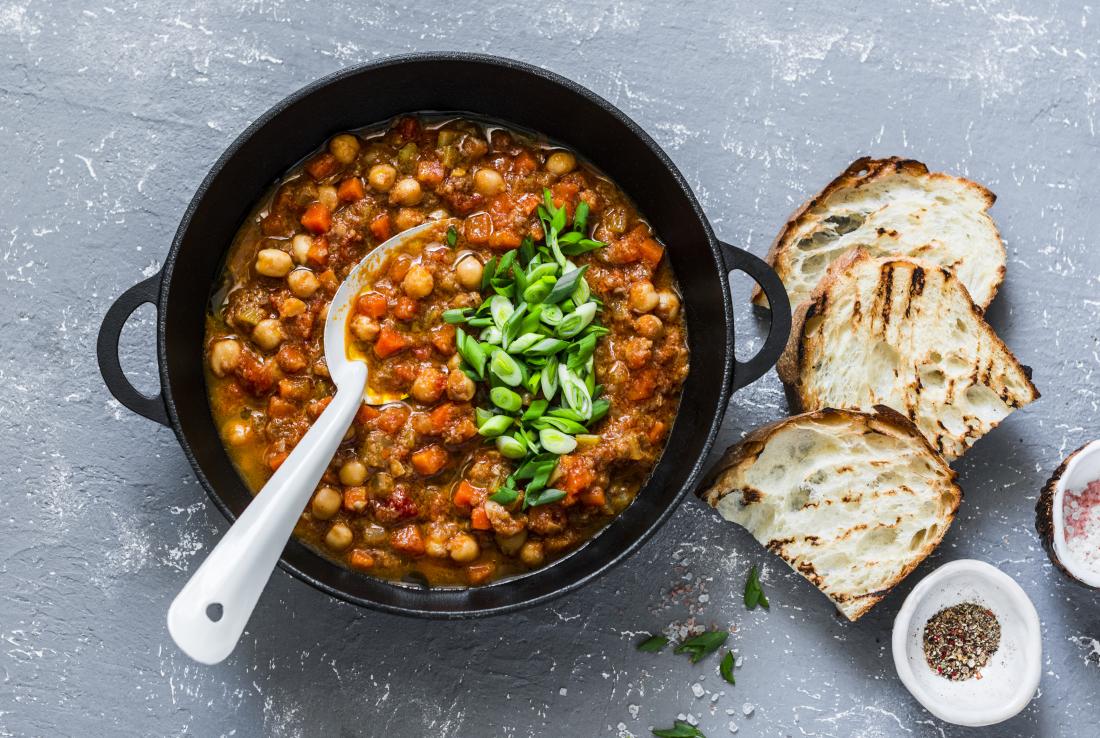Most people can follow a high-protein diet by eating meat, fish, dairy products, beans and legumes, eggs, and vegetables that are relatively rich in protein, such as asparagus and spinach.
People on this diet will often choose to reduce their carbohydrate intake, which may involve limiting their consumption of highly processed foods, bread and other baked goods, candy, and white pasta and rice.
There are some well-known high-protein diet plans, such as the Atkins diet. However, a person can increase their protein intake on their own with or without adjusting their intake of other food groups.
In this article, we explain how to eat a high-protein diet, foods to include and exclude, and the potential adverse effects of adopting this diet.
Benefits

Combining beans and legumes with other sources of protein can ensure a person gets all essential amino acids.
In addition to aiding weight loss, protein provides the body with some essential benefits. The benefits of protein include:
- providing enzymes that help power thousands of chemical reactions throughout the body
- helping the body maintain and repair hair, skin, muscles, and bones
- certain proteins are necessary to produce hormones that help the body’s organs and cells communicate
Protein also provides amino acids. There are 22 amino acids, nine of which are essential to obtain from the diet because the body does not produce them.
Protein from animals tends to contain all of the amino acids, so people refer to it as a complete protein. In contrast, many plant proteins only provide some of the amino acids, meaning that people need to combine them with other protein sources to get all of the essential amino acids.
What does the science say?
There has been a lot of research on the role of protein in short-term weight loss and muscle gain. However, the long-term effects of a high-protein diet require further study.
Some studies suggest that health problems may potentially result from eating a high-protein diet for extended periods. The authors of a review paper focusing on the high-protein diet warned that it could lead to higher acid loads for the kidneys and that people may be at risk of the health conditions that come with eating high amounts of animal fat.
In addition, diets that limit carbs may harm a person’s health. Children and teenagers are at particular risk of malnutrition from eating insufficient carbohydrate.
Still, most research indicates that high-protein diets are beneficial for weight loss, at least in the short term.
How to eat a high-protein diet

Keeping a food journal can help when following a diet plan.
There are many possible ways to include more protein in the diet, even for those with other dietary restrictions.
For example, people who follow a vegetarian or vegan diet or those who avoid dairy can still eat a high-protein diet.
People can either adjust their current diet to include more protein or follow a specific high-protein diet plan.
Taking the steps below may help a person when they start a high-protein diet:
- figuring out their individual protein needs, which will depend on their body weight
- making meal plans for the week
- finding and using high-quality proteins
- including at least 25–30 grams (g) of protein in each meal
- keeping a food journal to track the amount and types of food that they eat
- eating well-balanced meals
- including both plant and lean animal sources of protein in the diet
Foods to include and exclude
Choosing the right foods when eating a high-protein diet is important for maximum effectiveness.
Below are some excellent protein choices that could be suitable for a variety of dietary plans:
- eggs
- leaner cuts of beef
- chicken breasts
- turkey breasts
- beans, such as garbanzo beans or black beans
- shrimp
- nuts and seeds, such as pumpkin seeds, peanuts, and almonds
- fish, including salmon, flounder, and haddock
- sprouted grain bread, such as Ezekiel bread
- whey or plant protein shakes
- lentils
- quinoa
- chickpeas
- oats
- dairy products, such as Greek yogurt, cow’s milk, or cheese
- vegetables, including Brussels sprouts and broccoli
People with necessary dietary restrictions should also continue to exclude unsuitable foods. For example, a person who has lactose intolerance should not use milk products to increase their protein intake.
A person should generally also avoid the following foods as part of the high-protein diet:
- products that contain refined sugar, such as candy, baked goods, and sodas
- highly processed foods
- foods that manufacturers market as “diet” products, as they often contain excessive amounts of artificial sweetener
Risks

A person should speak to their doctor when considering a high-protein diet.
Most people can safely follow a high-protein diet, at least for a short period.
While some studies indicate that high levels of protein may negatively affect the kidneys, other research shows that people with healthy kidneys will not experience any adverse effects.
However, clinical evidence does suggest that people with kidney disease should not eat a high-protein diet.
Similarly, it seems that people who are susceptible to kidney stones should avoid high-protein diets, particularly those that include lots of animal proteins.
People with other medical conditions should speak to a healthcare professional before adopting a high-protein diet.
Although short-term studies show that high-protein diets can encourage weight loss,
it is important to remember that there is no research looking at the long-term effects of high-protein diets on overall health.
Takeaway
People looking to adopt a high-protein diet can follow an existing diet plan or adjust their intake of protein themselves to suit their needs. However, those who want to increase their protein intake should aim for each of their meals to include 25–30 g of protein.
People should focus on eating a combination of lean animal proteins and plant-based proteins for optimal results. Anyone with kidney disease should not follow a high-protein diet.
A healthcare professional or registered dietitian can provide more advice on how to start a high-protein diet and how to increase protein intake healthfully.
